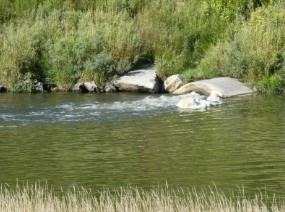By Eric Hamilton
Have you ever thought about where your waste goes? For people living in cities, it goes to a treatment plant. However, treated wastewater ultimately finds its way into a local waterway. This means it could end up in your nearby stream, river, or lake.

Treated wastewater flowing into the Grand River from Waterloo, Ontario, in Canada. While treated wastewater reduces the threat for disease, it still releases nutrients into waterways that can impair aquatic ecosystems.
Although wastewater treatment reduces the threat of disease, another problem remains: nutrients. Wastewater contains a lot of nutrients (nitrogen and phosphorus), including from pee and poop. All plants and animals need nutrients to grow and thrive; however, too much of a good thing is a big problem, particularly for waterways. Rivers get sick when too many nutrients impair the ecosystem. One of the worst offenders is excess ammonia.
“Ammonia is a nitrogen compound produced by the breakdown of organic matter in sewage. Discharge of ammonia into waterways can have direct toxic effects but also cause significant oxygen depletion that threatens the survival of aquatic life, including fish,” says Helen Jarvie. A professor of water science at the University of Waterloo in Canada, Jarvie studies how these nutrients affect waterways.
The study was published in the Journal of Environmental Quality, a publication of the American Society of Agronomy, Crop Science Society of America, and Soil Science Society of America.
Jarvie and her team studied what happened when two Canadian cities upgraded their wastewater treatment plants. Waterloo and Kitchener both sit along the Grand River. The Grand River is Canada’s largest river draining into Lake Erie. Over the last decade, the two cities began a program called ‘nitrification’ at their wastewater treatment plants. Nitrification turns ammonia into other types of nitrogen.
“This ultimately reduces the amount of ammonia in the wastewater that’s discharged into waterways,” says Jarvie.
Click here to see more...